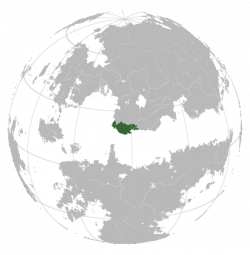Archive:Bodny
This article is still under heavy construction and may not be in a workable state for a while. Please check back later.
| Bothanian Republic vípelíno bótanén Vípelíno Bótanén |
||||||
|---|---|---|---|---|---|---|
|
||||||
| Motto: Vímzavé nesen chek It goes without saying |
||||||
| Anthem: Tyldarérní The Tyldarian |
||||||
| Capital and largest city | Galadrosia | |||||
| Official languages | Bothanian | |||||
| Demonym | Bothanian | |||||
| Government | Unitary parliamentary republic | |||||
| - | President | |||||
| - | Prime Minister | |||||
| - | President of the Great Law Courts | |||||
| Legislature | Great Law Courts | |||||
| Establishment | ||||||
| - | Letsatian colonisation | |||||
| - | Letsatian-Vaniu peace | |||||
| - | Constitution granted | 18 December 1865 | ||||
| - | Republic proclaimed | 28 March 1920 | ||||
| Area | ||||||
| - | Total | 599,643 km2 231,523 sq mi |
||||
| Population | ||||||
| - | 2016 estimate | 18,349,076 | ||||
| - | Density | 30.6/km2 79.3/sq mi |
||||
| Currency | Bothanian crown (BTZ) | |||||
| Time zone | BRST (+1:30) | |||||
| DST not observed | ||||||
| Drives on the | right | |||||
| Calling code | +75 | |||||
| ISO 3166 code | BT; BTH | |||||
| Internet TLD | .bt | |||||
Bothania (Bothanian: Bótanja, /botˈtanja/), officially the Bothanian Republic, is a nation located in southwestern Vaniu. One of the southernmost countries on the continent of Miraria, Bothania has borders the Gulf of Sharkunen to the west, the Parshita Sea to the south, terra incognita to the east and Sotanxina to the north.
Etymology
History
Early history
Letsatian colonisation
Bothanian Commonwealth
Terminian era
Bothanian Kingdom
Revolution and civil war
Modern Bothania
Geography
Geology
Climate
Biodiversity
Politics
Law and judiciary
Administrative divisions
Foreign relations
Military
Economy
Transport
Energy
Science and technology
Tourism
Demographics
Ethnic groups
Urbanisation
Language
Education
Healthcare
Religion
Culture
Heritage
Architecture
Literature
Art
Music
Theatre
Film
Cuisine
Bothanian cuisine has developed over the course of centuries of social and political changes. With roots in antiquity and heavy influence from the palates of Vaniu and Ekuosia, Bothanian cuisine is noted for its heterogeneous tastes and large degree of simplicity; Bothanian cuisine traditionally relies on the quality of ingredients rather than elaborate preparation. Dairy, fish, rice, legumes and fruits form a large part of the Bothanian diet and the country is noted for its significant diversity and quality of wines, cheeses, coffee and confectionary.
Lamb, beef, goat, chicken and seafood form the base of the Bothanian diet and are commonly prepared with vegetables and starches in a soup or stew fashion or are salted or pickled, especially in the desert interior. Food stalls are popular around the country, often selling confectioneries or meat-based street food.
Bothania has a long and storied confectionery tradition dating back to the recording of fruit pastry recipes by Iovist monks in the third century CE. Bakers’ confections such as pastries, tarts and cakes are staple desserts across the country, while Bothanian chocolate and sweets are widely appreciated. Ice cream is also commonly eaten as a last course and is traditionally accompanied by fruit and a cup of coffee.
Sport
Association football is by far the most popular spectator sport in Bothania and is traditionally considered the country’s national sport. Governed by the Bothanian Football Federation, the Bothania national football team competes in in international competitions such as the SIFA World Cup. Clubs compete in the Bothanian league system, which is headed by the Bothanian Championship, as well as the knockout Bothanian Open Cup. Football’s main competitors for viewership are rugby, handball and volleyball.




